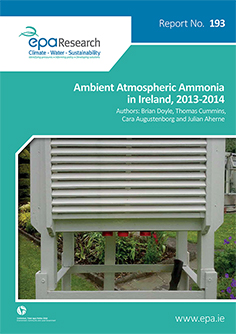Authors: Brian Doyle, Thomas Cummins, Cara Augustenborg and Julian Aherne
Summary: EPA Research report on Ambient Atmospheric Ammonia in Ireland 2013–2014

Sources of atmospheric ammonia increased throughout the 20th century as a result of N-fertiliser production and intensive farming practices, increasing nitrogen deposition in sensitive ecosystems. There are limited monitoring data on ambient atmospheric ammonia in Ireland since a previous, comparable survey in 1999–2000. In this study, ambient atmospheric ammonia concentrations were measured at 25 monitoring sites across Ireland between June 2013 and July 2014, using passive diffusive samplers, exposed in triplicate on a 2-week cycle, away from point sources of ammonia. Monitoring shows higher concentrations of ammonia towards the north-east midlands and the southeast of Ireland, both areas of relatively intensive agricultural activity. Concentrations are associated with regional activity indicators for pig and poultry farming, cattle, and crop production.
The ammonia concentrations observed are above the threshold for potential impacts on the most-sensitive ecosystems, but below those for the less-sensitive seminatural vegetation types, as determined by the Convention on Long-Range Transboundary Air Pollution. A new observation here is that ammonia levels are also elevated in the Dublin urban area. Since clear relationships are shown between nitrogen-intensive agricultural activity and ammonia concentrations, this study is relevant to revision of emission limits under a revised National Emission Ceilings Directive.
This study proposes that a permanent monitoring network is required to provide quantitative atmospheric ammonia measurements, especially in the context of the national Food Harvest 2020 and Food Wise 2025 government strategies, which aim to increase production across multiple agricultural sectors. Such a network would give continuous monitoring of atmospheric ammonia, allowing detection of long-term trends, and forming a basis for modelling to assess the likely effect on ecosystems and human health. Since this method establishes background concentrations of ammonia away from point emission sources, it is essential as a basis for impact assessment around new and existing emission sources, and evaluating the effects of nearby sources on specific sensitive and protected ecosystems.
https://www.epa.ie/media/epa-2020/publications/research/Research-193-Ambient-Atmospheric-Ammonia-in-Ireland-2013-2014.jpg